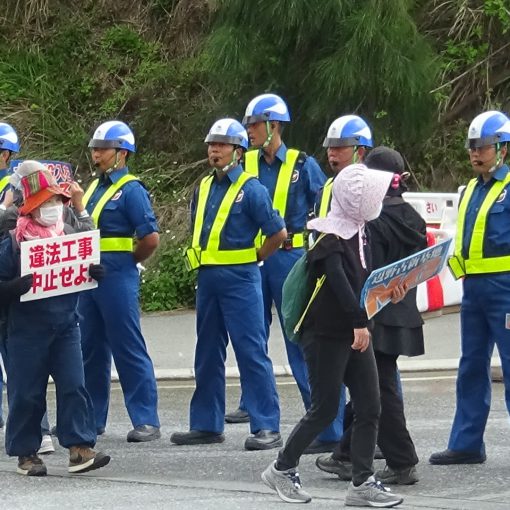January 18, 2020 Ryukyu Shimpo
It has now been 60 years since 1960, when the U.S.-Japan Security Treaty was revised. For 60 years Okinawa has been left to suffer damage from military bases in the name of the security guarantee.
Outside of Okinawa there has been a reduction in U.S. military bases, meanwhile, the concentration ratio of military bases in Okinawa has increased.
The Abe administration pushed past Okinawa’s popular will in opposition to the construction of the Futenma Replacement Facility in Nago City, and is forcing construction through.
It can be said that the Japanese government’s posture of compliance to the United States has furthered
Okinawa’s sacrifice. The Japanese government’s compliance with the United States’ wishes has taken the form of the Japanese Self-Defense Forces (JSDF) taking on a larger scope of activities, and Japan shouldering stationing expenses for the U.S. Forces, Japan (USFJ), which Japan has no duty to pay.
The payment of U.S. military stationing expenses by Japan is called the Omoiyari Yosan (or “Sympathy Budget”) which from 1978 to 2018 reached a cumulative total of over 7.2 trillion yen (approximately 66.7 billion USD).
The burden of USFJ stationing expenses, which was originally borne by the United States, has come to be 70 percent borne by Japan as the Omoiyari Yosan.
The amount requested by the United States has been rising, reaching 197.4 billion yen (approximately 1.8 billion USD) in 2019 alone.
Although the subject of the budget has not changed, when comparing it with various public works, for example, the budget dedicated by Japan to urgent countermeasures to “Childhood Poverty” in Okinawa, the Omoiyari Yosan is 152 times the yearly “Childhood Poverty” budget.
The Okinawa prefectural government has shown preliminary calculations for the extension of the Okinawa Urban Monorail (Yui Rail), a sum which should cover the construction of 16 stations spanning 18 kilometers (a little over 11 miles).
The itemized list includes: (1) 9 stations from Onoyama Park Station through Tomigusuku City to Itoman City (98 billion yen, approximately 899 million USD), (2) 4 stations from Tedako-Uranishi Station to Nishihara Marine Town (58 billion yen, approximately 532 million USD), and (3) 3 stations from Tedako-Uranishi Station to the University of the Ryukyus (40 billion yen, approximately 367 million USD).
According to the Okinawa General Bureau, the reconstruction cost for buildings burned down in the Shuri Castle fire is about 7.3 billion yen (approximately 67 million USD).
The 2019 Omoiyari Yosan costs about 27 times the reconstruction budget of Shuri Castle.
Holding the February 19 prefectural referendum pertaining to construction of the Futenma Replacement Facility in Henoko, Nago City cost 550 million yen (approximately 5 million USD).
A portion of Okinawa’s citizens and conservative politicians were doubtful of this use of tax money. The 2019 Omoiyari Yosan costs 359 times the cost of that prefectural referendum.
In 1978 the U.S.-Japan Status of Forces Agreement (SOFA) regularized Japan sharing responsibility of USFJ stationing expenses.
At that time the Director-General Kanemaru Shin of the Japan Defense Agency expressed “We are sympathetic [to the United States]” and thus called it the “Sympathy Budget”.
Japan is bearing the costs of efforts such as the return of U.S. military bases and the relocation of trainings within Okinawa, and U.S. military reorganization expenses including the relocation of Marine Corps Air Station Futenma to Henoko, Nago City.
Policies that favor U.S. servicemembers and civilians in military employ, such as exempting them from taxes and various fees, are in effect.
The most recent information on ratios of responsibility sharing by host nations for U.S. military stationing expenses was announced by the U.S. Department of Defense in 2004.
According to the report, Japan was responsible for 74.5 percent of the U.S. military stationing costs within Japan, which greatly exceeds the responsibility sharing ratio of any other country.
There is expected to be movement toward conclusion of a new agreement in March 2021, as the Trump administration is requesting an increased sum from Japan.
(English translation by T&CT and Erin Jones)





